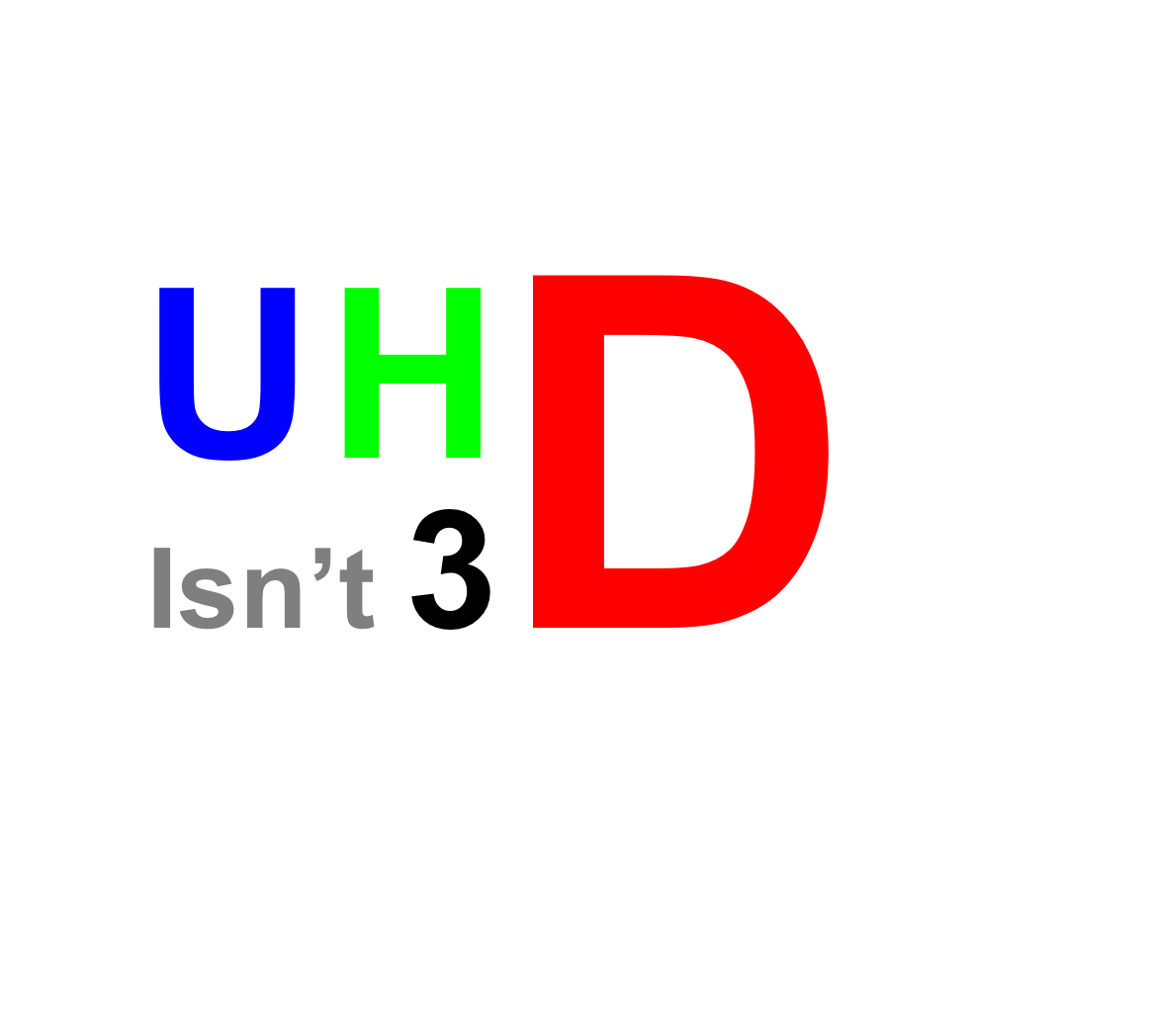Désolé, cet article est seulement disponible en Anglais Américain. Pour le confort de l’utilisateur, le contenu est affiché ci-dessous dans une autre langue. Vous pouvez cliquer le lien pour changer de langue active.
Las Vegas was again focused on UHD in 2016, at least through my eayes. The four Keywords I came away with were 1: UHD (again), 2: HDR, but also 3: VR and 4: All-IP production. Of course other things like drones were important, but I'm not a real journalist, I don't know how to write about things I don't know.
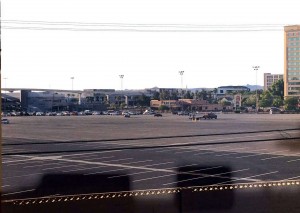
We got in from Europe on the Saturday evening and this year I was on a budget so we stayed in an Airbnb apartment with my colleague Marta. It turned out to be just behind the main LVCC parking lot. On Sunday morning, you can see on thE right what the parking looked like when you arrive before the show is really underway.
Size and growth of the industry
On the Sunday I sat for a moment through the "Media Technology Business Summit" run by Devoncroft and learned abit about the industry trends:
- Starting with radio shows this year’s NAB is the 94th annual Show, so I suppose in 6 years we’ll have a big bonanza, I wonder if we’ll have something like Augmented Reality in 8K by then.
- Devoncroft sees the global media being market worth 49bn in 2015 with the US Media industry having pushed revenue per user to the limit. 3000 vendors make up their industry panel and 2009-2015 CAGR was 1,9% with 2014-2015 OpEx spend at -4.2% and CapEx spend at -4.4%.
- Despite the OTT craze and losing traditional subs, ESPN still gets 7$/Month from linear subscriptions, but only 0,42$/Month from OTT viewers, so hold your hats, linear pay-TV ain’t dead quite yet. Beyond sports, Devoncroft argues that even though there is growth, digital revenues are insufficient to replace linear ones. The big issue is how the ad market can transition.
- 4K and UHD make up the third most import topic for respondents of Devoncroft's 2016 Big Broadcast Survey the results of which will soon be released. But Demand for UHD is less for “more pixels” than one for “better pixels”. So according to Devoncroft, like Ericsson, the HDR Vs. 4K debate is all but over.
Virtual and Augmented Reality
I then popped into an Augmented Reality (AR) conference where Gary Acock and Juan Salvo were discussing how to add live content to the UnReal video gaming engine. AR is seen as bringing the real world into Virtual Reality (VR). Stitching 360° video is still apparently a “pretty unpleasant experience” and French startup VideoStitch was mentioned as one of the key players working on fixing this. Currently 360° production design is limited by how effectively you can stitch video. But with AR there are also Inherent UX limitations like parallax issues with head movement or camera movement when there’s no head movement. With AR one needs to always know where the head is and how it's positioned as head movements affect the content that is being created.
The amount of data to process for VR can be well over 1TB / hour so the coming (?) VR/AR revolution needs powerful GPU and CPU.
AR, VR and any immersive experience are still moving targets in 2016. But neither AR nor VR are isolated from the broadcast experience anymore. Indeed VR is less of an isolating and lonely experience, but a new way of engaging, a bit like coming to a conference and interacting with social media on a smartphone at the same time. Content is still king and creating compelling content remains the goal where AR & VR are just other tools. As we still don't have toolsets like an « Adobe for AR/VR » we need to jerry-rig existing tools.
A VR demo that was not at NAB intrigued me. Frauhoffer’s Stephan Steglich told me about FAME. It’s the simple idea of navigating the 360 video with a remote control. 2 key advantages are removing the isolation aspect of having to wear something over the eyes and moving all the processing to the cloud, allowing for future-proof deployments. It sounded convincing but I’ll wait for a compelling demo before making an opinion.
Showstoppers
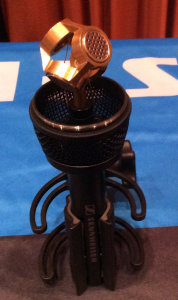
I had been told great things about the CES Showstoppers being a big event, at my first experience at NAB, it was a very focused affair where great food and wine seemed to be as attractive for the media as the companies to visit.
German manufacturer Sennheiser was showing off their latest MKE440 DSLR microphone, which they say is the first mini-shotgun for HQ stereo sound image in one take. I was more taken by the beautiful design of the prototype VR microphone that goes under VR camera.
I met up with V-Nova’s Fabio Murra who was showing their two OTT deployments based on their Perseus codec. FastFilmz launched on March 26 in India offering SVoD to a mobile-only Tamil customer base with a potential of 120m subs. There were 350 titles at launch and according to V-Nova, Perseus made the business case possible in southern India where only 2G is available in some areas, offering a 64-128 kbps bandwidth. The demo I saw was watchable at 120kbps using 14 fps (I had to point that out though). The Perseus codec is described as “hybrid on top of H264” with a metadata stream on top of H264. I’ll be looking to dig into this a bit more as I no longer understand exactly what this means after a heated discussion several analysts. Content is protected with DRM I couldn’t find out by who.
I only glimpsed the other demo of a 4K STB using OTT delivery. It was showing Tears of Steel at 4mbps and looked fine but without any wow effect at least for what was on screen then, or maybe it was just that I was too far away for the small screen.
V-Nova had already announced a contribution deal with Eutelsat and promised another one for the next day (which turned out to be Sky Italia).
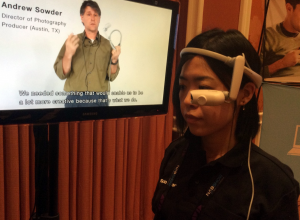
The Japanese company Brother that I wrongly thought of as a printer maker (does any Japanese company do only one thing?) was displaying « Airscouter », a surprising head-mounted monitor designed for cameramen in difficult positions. You see a 720p resolution image in the corner of one eye. It was a bit disconcerting and I guess limited to some very specific use cases. I felt a bit nauseous with it on my head but it does really work and felt maybe like what Iron Man might feel.
Ultra HD Forum
Monday was taken up with Ultra HD Forum activities for me. We had our own press conference in the morning and in the after noon I made a tiny presentation during the Pilot press conference in the Futures Park. I discussed, the forum’s reason for being, it’s history, our Plugfest #1, the Guidelines 2016 and the general « Work in Progress » aspect of live UHD.
« Pilot » is new name for « NAB Labs » that was started in 2012. We were among 30 exhibitors in Futures Park, which aims to promote « Edge of the art » concepts that are not yet commercialized. ATSC 3.0 was the star with 15 companies focusing on that alone. Other stuff is very diverse ranging from commercial R&D, government to academic research. NHK 8k Super High Vision was prominent as usual and the Nippon public broadcaster is still scheduled to launch commercially in 2018 « so people can enjoy in 2020 Japanese Olympics » in glorious 8K HDR with HFR.
Security and analytics
Monday night was over-booked and I chose the Verimatrix media dinner. I had some animated discussions on UHD and the extent to which HDR might be the only big game-changer (I still believe in 4K but am feeling more and more lonely on that front). Tom Munro the CEO gave me a great update on the company strategy and how the move towards analytics, which I now understand can be a logical progression for a security vendor. If the financial transactions are precious enough to secure, then private usage data is worthy of the same efforts. More on that in a dedicated blog soon.
Satellite industry on edge of a cliff and might UHD save it?
On Tuesday I got myself to the Satellite industry day. I have this vision on the industry (at least the broadcast and the Telecoms parts of it) sitting on the edge of a cliff wondering when fiber, 5G and delinearization will push the off the edge.
Despite a great lineup with Caleb Henry of Via Sat Mag, Steve Corda VP Bizdev SES, Markus Fritz Eutelsat, Dan Miner AT&T and Peter Ostapiuk of Intelsat, the opening panel didn’t really give me any new ideas to tackle that problem.
AT&T in particular sees similarities between the move from SD to HD and that from HD to UHD, but IntelSat sobered the audience asking how the content industry will make money from upgrade to UHD. SES’s Steve Corda made it scarier still reminding the audience that during the upgrade from SD to HD we didn't have competition from OTT as we do now with most early UHD coming from OTT suppliers.
The satellite industry panel agreed that demand for UHD channels is growing especially from their cable operator clients and that the bottleneck is still available content. AT&T's Dan Miner noted that a key change in OTT delivery in the coming 18 months is that US data plans will enable the TV Everywhere on cellular networks.
The consensus is that to have a monetizable UHD offering you need a bouquet of at least 2 channels, ideally at least to 5 including sports.
When the panel went round enumerating their live 4K services, I counted about a dozen UHD linear channels and as many demo channels as well as a few events based channels.
One of Viasat’s founders Mark Dankberg gave an inspirational talk reassuring the audience that the satellite industry’s future is safe, at least if they copy Viasat. The merger of AT&T and DirecTV is an indicator to him that Satellite without broadband is no longer viable in the long term. Viasat started 1986 in defense, during the 90's they got into VSAT (Data Networking) just on the B2B side. Dankberg believes high –orbit geostationary is still the way to go (instead of mid of low-orbit (LEO)) because it’s the best way to optimize resources with thousands of beams. He points out that as 95% of demand is in 15% of geography; LEO that orbit the earth can't do that. I was enthused by his talk and hoping to get home and write a blog about it, but when I looked through my notes I realized that in the end there wasn’t any new information, just the charisma and communicative beliefs of an industry veteran.
TV Middleware on Android
Beeniuis, the middleware guys from Slovenia that I’ve written about a few time caught me in the south hall so I went to have a look.
In demonstrating their new version 4.2 core product, Beenius told me that the EPG is dead but still went ahead to show me theirs. Navigation is via genres with favorite channels on top of a carousel that mixes live and VoD. Recommendation currently uses their own algorithms but can be based on Think Analytics with « Trending » content on second line.
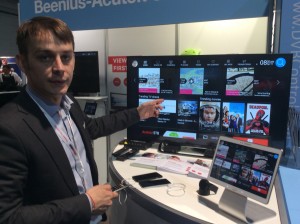
The company is very Google-centric, although they still have a Linux offering with a Hybrid DVB solution. They clarified to me how GooglePlay apps can be controlled by the TV operator with three different approaches:
- 1. Preinstalled apps and an open GooglePlay
- 2. « Walled Garden » where the user chooses apps from the operator’s list typically among a dozen including YouTube, Netflix, etc.
- 3. Apps already embedding into the UI, which is also a closed model.
VoD also benefits from integrated recommendation but is open to extra info from the Web such IMDB content.
Beenius haven’t had much interaction with 4K yet, although they say they are ready. As with any competitive TV middleware you can fling content from screen to screen.
The operator-controlled UI can be updated from a central server so that a new version of the App gets automatically pushed to STB via GooglePlay as soon as it's closed and reopened. Playing in the google arena has enabled a full-featured app for Android powered smart TVs, Beanies just needs Google to finally get it right in the living room.
Automatically generated HDR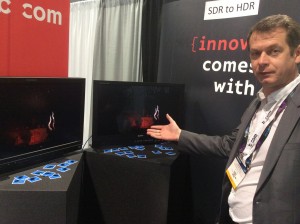
Ludovic Noblet of French institute of research B<>Com showed me a tool to up-convert SDR content to HDR. He sees it as a gap-filler for legacy setups which is already available for offline, with a real-time version planed for IBC 2016. The current version introduced a latency of just 3 images and was convincing even if it didn’t carry that amazing wow-effect of some native HDR content. He was very secretive about the first customers but seemed very confident.
The pull of social media
On the last day I had a quick stop at Texas Instrument’s tiny booth, simply because they engaged with me on twitter ;o)
The LMH1219 is a 12G SDI card shown above enables SDI cables to be up to 110m without any signal attenuation, instead of the usual 20-30m. Its UltraScale processing equalizes and Improves the signal. The TI chip is agnostic to metadata so should work fine with HDR for example.
Another hardware innovation they showed me was a single chip for receive (Cable EQ) or drive mode (TX) that makes BNC connectors more versatile as they needn't be just IN or OUT but can be either. The device isn’t available yet nor does it have a product name. Launch is expected in Q1 2017.
Note that I didn’t interact with any of the All-IP production vendors, but just noted it as a buzzing theme in conferences and on booth signage.

Oh and the Convention Centre car park looked like this from our apartment window by 9:30 am Monday through Wednesday:
That’s all for now folks.
